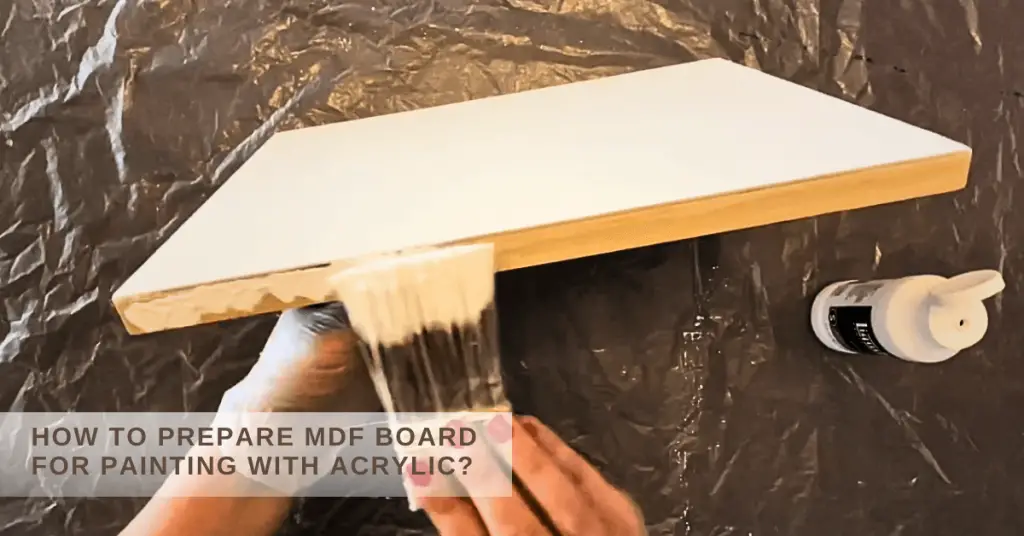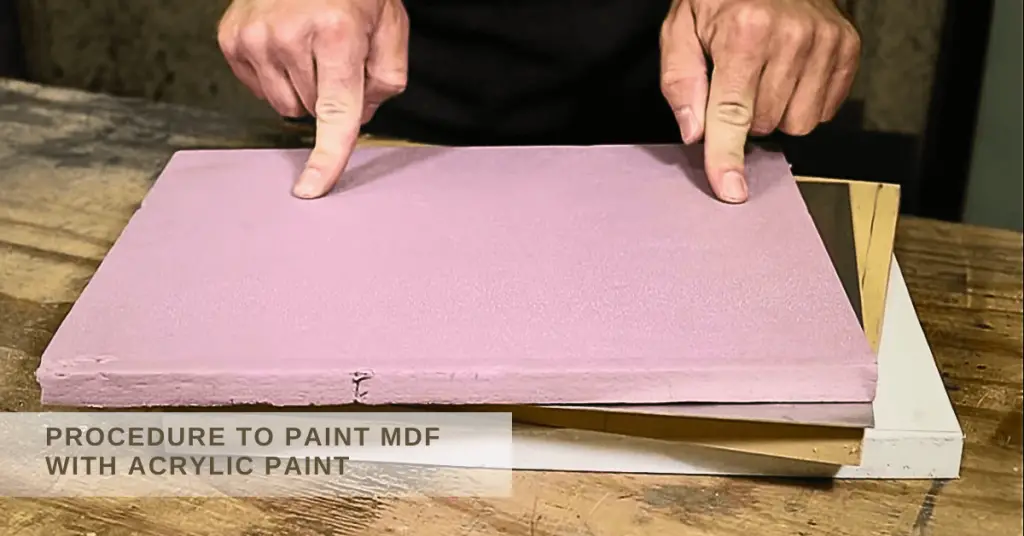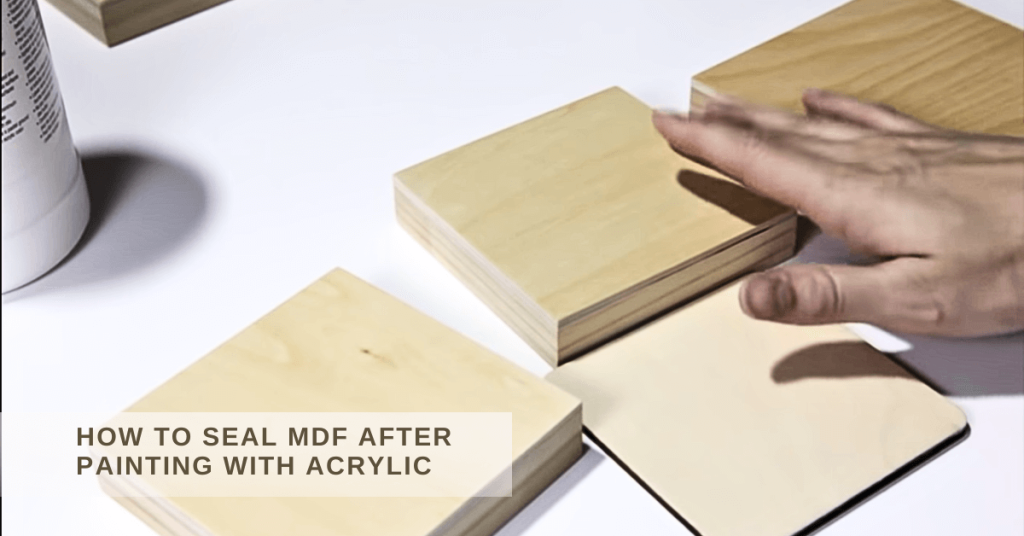What is MDF? MDF is a porous household wood material primarily used in furniture. It is sometimes termed a medium-density fibre composed of wood fibre and specific resin compounds. You can give it a stunning look by painting it.
The wood can be used for practising different arts and trying paints. Hence, it is a good surface for newbies to start with. You can paint the wood with several paints, but I recommend acrylic.
So, can we use acrylic paint on MDF? Yes, I usually paint such types of low-density surfaces with acrylics, and they give excellent output.
In the blog post, I’ll make you comprehend how to prepare the fiber before painting, the complete procedure of acrylic painting on MDF board, and methods of priming and sealing the wood.
How To Prepare MDF Board For Painting With Acrylic?
Preparing any surface before painting is crucial and it promises good results with a durable finish. The same applies to preparing MDF for painting. Without preparation, the dirt and dust particles may contaminate the primer and the paint, resulting in an unstable finish. So do it the following way:
- Cleaning the board: The first step is removing all types of physical debris, including dust particles, stains, spills and other kinds of dirt. It should be done using water and good-quality detergent or soap. After washing the surface thoroughly, wipe it well with a dry clean piece of cloth.
- Sanding the surface: Next move is sanding the top of the surface of the board. I usually use small-sized fine-grit paper for sanding down wood surfaces like MDF. Sanding causes the surface to get smooth and even, and at the same time, it provides room to the paint so that the coat sticks to the surface. You can learn more about how to sand a surface here.

How to Prime MDF for Acrylic Painting?
Priming a surface before painting should never be skipped. It is advised to apply a primer the right way before moving on to painting, as it increases your chances of getting a long-lasting finish on the surface. Moreover, priming prevents the acrylic paint from seeping through the surface. Here’s a complete procedure:
Supplies Required:
- Gesso primer
- Cup of water
- Paintbrush
- MDF
- Roller
- A piece of Cloth
- Piece of newspaper
Procedure:
- Put a newspaper beneath the fibre board to prevent the floor from staining or spilling.
- Pour some primer out of the container and put it over the board.
- With the help of a roller, begin spreading the primer over the surface equally.
- Suppose you’re doing it with a brush; better to begin with light strokes and cover the surface well. The surface should be primed equally.
- Once you have covered the surface thoroughly, wait for the gesso to get dry before going for further procedure.
Procedure To Paint MDF With Acrylic Paint
After preparing the board successfully and priming it well, the next one is the core step, where you have to paint the surface. It’s fun and exciting, and I usually enjoy applying acrylic paint on MDF board to discover more about painting. You can paint it in the following way:
Supplies Needed:
- MDF surface
- Newspaper
- Acrylics
- Roller
- Sandpaper
- Cup of water
- Paintbrush
- Piece of cloth
Procedure (Step by Step):

Step 1: Put a Newspaper on the floor
No matter whether you’re painting, putting the board on the floor, or you have a stand to hold the board, always put a newspaper or cloth nearby the floor where your board is going to bathe in the colours. It’ll protect your floor from stains and spills.
Step 2: Pour the colours into separate cups
The next step is pouring the colours into separate cups so you do not have to take them out during the painting. Try using multiple colours. Light and dark should both be experienced. Light colours are suitable for painting the base, while dark ones will add a look to the core of the artwork.
Step 3: Apply the paint
Apply the paint to the surface using a roller or paintbrush. I like using a roller as it is pretty sharp and makes it easy to spread the paint. A paintbrush is suitable for a defined section to be painted. No worries, both can be used depending on their turn.
Step 4: Leave the paint to get dry
Finally, leave the paint to get dry. It usually takes up to 6-12 hours, depending on the type of paint and conditions you have provided. For the second coat of acrylic paint, repeat the procedure above.
How To Seal MDF After Painting With Acrylic? Stepwise
Sealing the paint on MDF is essential, or you’ll get cracks and flexes on the board’s surface over time. Sealing protects the paint from getting hurt and ensures long-lasting. Moreover, it is resistant to a variety of environmental conditions. You can seal the paint in the following way:
Supplies You’ll Need:
- MDF
- Paintbrush
- Newspaper
- Piece of cloth
- Varnish ( Sealer)
- Roller

Procedure:
Step 1: Select a sealant
The first step is selecting a good sealer compatible with your paint. As we know, acrylic paint is water-based, so the sealer should be water-based for a better combination. A polyacrylic sealer is a good option in this regard. Being composed of water as a solvent, it dries in no time.
On the other hand, the varnish is composed of oil solvent, making it take time to dry. But it can be applied as well to the acrylic coating. I recommend you select a water-based sealer.
Polyurethane can also be used for sealing acrylic paint. Learn more about it.
Step 2: Apply the sealant
Open the container carefully and pour a small amount of sealer over the board directly. Spread the mix evenly with the help of a roller. Another way is pouring the sealant into a small bowl and dipping the brush into it, and applying it over the board.
Both ways are good and work well. But make sure the sealant has covered the whole painted section on the board and is symmetrical.
Step 3: Dry the surface
After the sealer has covered the whole board and you’re done, leave the board to dry. It will take up to 2-6 hours, depending on the type of sealer.
You can speed up the drying process with the help of a hair dryer, fan or ventilation.
How Much Time Do Acrylics Take To Dry?
Acrylic paint takes 10-20 minutes to get dry to touch once applied on the surface of MDF. But the paint takes up to 12-24 hours to fully cure. However, it all depends on the brand type and thickness of the acrylic paint. Moreover, the surrounding environment also plays a vital role in drying the paint. How to speed up the drying process?
- Use a hairdryer
- Put the painting under a fan or air-conditioned room.
- Put the painting near a window.
Learn more about how long acrylic paint takes to dry.
Can You Paint MDF Without Primer?
MDF is porous wood material making it difficult to paint without a primer. You can paint the surface even if you don’t apply the primer. It will be a risk, and you may waste your hard work.
I’ve observed people not priming the surfaces get cracks and unequal paint distribution over the sheet, board, or paper. So I don’t recommend painting MDF without primer to ensure the best outcome.
Painting Directly Onto The MDF Surface:
If you’re thinking of painting your MDF directly without using the basic coat of a primer, you’re at risk of wasting your time and hard work.
Let’s clear out the concept of why we need a primer for MDF. The wood surface is porous and very smooth, which means the applied paint me get seep down the entire surface, and the adherence may not be as strong as expected.
So, we need to apply a thin layer of primer to make the acrylic paint adhere to the base of the MDF firmly. Moreover, priming helps you achieve an even finish and durability.
I use gesso for my smaller projects, and it has good coverage and can be found easily. Another good alternative is modge podge. Both primers are satisfactory.
How To Paint MDF Furniture?
MDF is a valuable wood material for shaping into cabinets and shelves. You can see this material in different shapes at your home in the kitchen, rooms, and bathrooms, and even your bed has some parts made of this wood material.
So can you paint this furniture? Yes, you can, but make sure to use good-quality paint and prepare the surface along with priming and sealing it. As long as acrylic paint is concerned, it is good to use with smaller shape MDF boards. But the cabinets and shelves should be painted with oil-based paint to give more coverage and durability.
Sand down the surface first, then prime with gesso or another good quality brand. Then apply the paint evenly with the help of a brush. Ensure the paint is thinned down well before using it over the furniture. Thin paint is much more resistant to cracks and rifts when dry.
How to get a smooth paint finish on MDF? Apply an oil-based sealer to get a glossy finish and protect the paint for the future.
FAQ’s
Can you paint mdf with acrylic paint?
Yes, you can paint acrylic on MDF materials. However, it is necessary to sand the surface lightly, followed by priming for better results.
What paint will stick to MDF boards?
MDF has a smooth and even surface, making paints challenging to stick to it. But applying a primer promises adherence. Oil-based paints are ideal for painting cabinets and shelves, while acrylic is suitable for smaller MDF boards.
Do I need prime MDF before painting?
Yes, you’ll need to prime MDF before painting it with acrylic or oil-based paint. Priming the surface gives protection, a durable finish and adherence ability to the paint. In addition, it protects the paint from seeping through the cover irregularly.
What is the best way to finish paint on MDF?
Once you have finished painting the MDF surface, you need a little more to give it ultimately and best finish. A sealer and fine-grit sandpaper would help in this regard. Sand down the edges and waves of the paint and apply the sealer, then. A smooth finish is ready!
How should I store acrylic-painted MDF artwork?
Store acrylic painted MDF artworks in a cool, dry place away from direct sunlight and moisture to prevent warping or deterioration of the MDF surface over time.
Final Thoughts
We have covered every aspect of the query, “ Can you use acrylic paint on MDF?” and found that we can do it if we are familiar with the proper strategies and have a good grip on handling the paints.
Thank you for reading!
- How To Buff Acrylic Enamel Paint In 5 Easy Steps? - February 2, 2024
- How To Make Acrylic Paint More Opaque? 10 Effective Methods - February 1, 2024
- How To Sketch On Canvas Before Acrylic Painting? Draw Like a Pro - January 31, 2024

